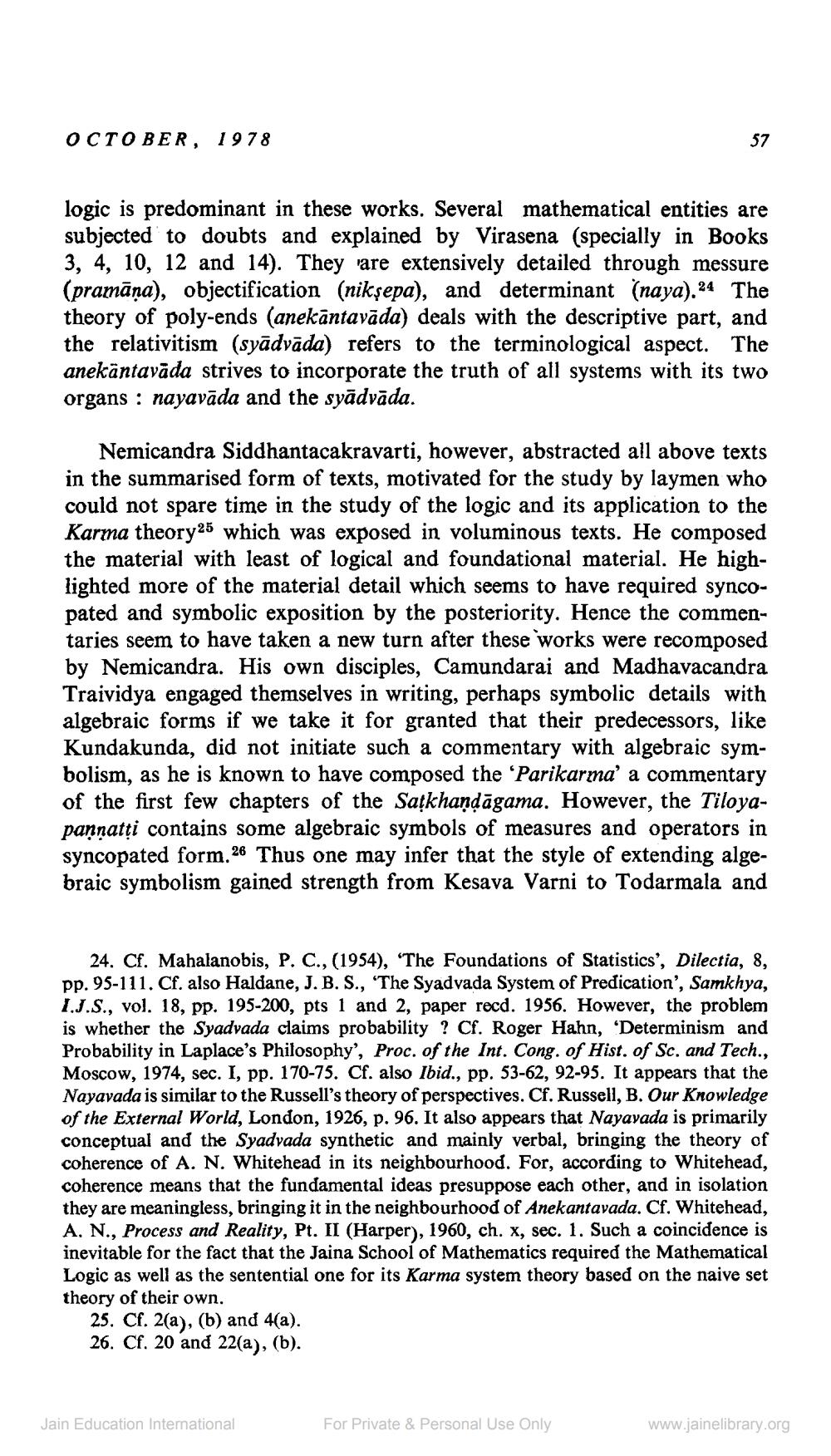________________
OCTOBER, 1978
logic is predominant in these works. Several mathematical entities are subjected to doubts and explained by Virasena (specially in Books 3, 4, 10, 12 and 14). They are extensively detailed through messure (pramāna), objectification (nikṣepa), and determinant (naya).24 The theory of poly-ends (anekāntavāda) deals with the descriptive part, and the relativitism (syādvāda) refers to the terminological aspect. The anekāntavāda strives to incorporate the truth of all systems with its two organs : nayavāda and the syādvāda.
Nemicandra Siddhantacakravarti, however, abstracted all above texts in the summarised form of texts, motivated for the study by laymen who could not spare time in the study of the logic and its application to the Karma theory25 which was exposed in voluminous texts. He composed the material with least of logical and foundational material. He highlighted more of the material detail which seems to have required syncopated and symbolic exposition by the posteriority. Hence the commentaries seem to have taken a new turn after these works were recomposed by Nemicandra. His own disciples, Camundarai and Madhavacandra Traividya engaged themselves in writing, perhaps symbolic details with algebraic forms if we take it for granted that their predecessors, like Kundakunda, did not initiate such a commentary with algebraic symbolism, as he is known to have composed the 'Parikarma' a commentary of the first few chapters of the Sakhandāgama. However, the Tiloyapannatti contains some algebraic symbols of measures and operators in syncopated form.26 Thus one may infer that the style of extending algebraic symbolism gained strength from Kesava Varni to Todarmala and
24. Cf. Mahalanobis, P. C., (1954), "The Foundations of Statistics, Dilectia, 8, pp. 95-111. Cf. also Haldane, J.B.S., 'The Syadvada System of Predication', Samkhya, I.J.S., vol. 18, pp. 195-200, pts 1 and 2, paper recd. 1956. However, the problem is whether the Syadvada claims probability ? Cf. Roger Hahn, 'Determinism and Probability in Laplace's Philosophy', Proc. of the Int. Cong. of Hist. of Sc. and Tech., Moscow, 1974, sec. I, pp. 170-75. Cf. also Ibid., pp. 53-62, 92-95. It appears that the Nayavada is similar to the Russell's theory of perspectives. Cf. Russell, B. Our Knowledge of the External World, London, 1926, p. 96. It also appears that Nayavada is primarily conceptual and the Syadvada synthetic and mainly verbal, bringing the theory of coherence of A. N. Whitehead in its neighbourhood. For, according to Whitehead, coherence means that the fundamental ideas presuppose each other, and in isolation they are meaningless, bringing it in the neighbourhood of Anekantavada. Cf, Whitehead, A. N., Process and Reality, Pt. II (Harper), 1960, ch. x, sec. 1. Such a coincidence is inevitable for the fact that the Jaina School of Mathematics required the Mathematical Logic as well as the sentential one for its Karma system theory based on the naive set theory of their own.
25. Cf. 2(a), (b) and 4(a). 26. Cf. 20 and 22(a), (b).
Jain Education International
For Private & Personal Use Only
www.jainelibrary.org




